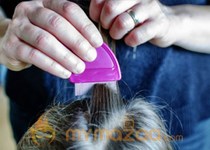Head lice might be a bit harder to nit, er, nip in the bud this year: A study out of Southern Illinois University-Edwardsvillle finds the pests have developed resistance to popular over-the-counter medications in at least 25 states.
Kyong Yoon, who helped discover ultra-resistant strains, collected 109 samples of lice from 30 states. "What we found was that 104 out of the 109 lice populations we tested had high levels of gene mutations, which have been linked to resistance to pyrethroids," he says in a press release.
Pyrethroids—a family of insecticides including permethrin, the active ingredient in common lice treatments—kill insects by latching onto receptors in their nervous systems. But lice have evolved so the chemicals no longer find a perfect fit.
That doesn't mean the treatments won't work, but you'll need a higher dose. CBS News reports 12 million American kids, ages 3 to 11, get lice each year.
Yoon specifically tested the samples for a trio of genetic mutations known as kdr. Samples in 25 states were most resistant with all three. Samples from four states, including New York, New Jersey, New Mexico, and Oregon, had one, two, or three.
Michigan was the only state where lice hadn't developed resistance. A dermatologist recommends following medication directions, which means applying a treatment a second time, five to seven days after the first.
If the first treatment didn't kill all the lice eggs, they'll hatch after a week, reports Today. If all else fails, a pediatrician can prescribe a treatment lice aren't resistant to.
What to avoid: Home remedies like olive oil and mayonnaise, since there's no proof they work. The same goes for fine-toothed combs, an expert says. The one all-natural treatment that is proven effective: destroying the habitat, aka shaving your head.










